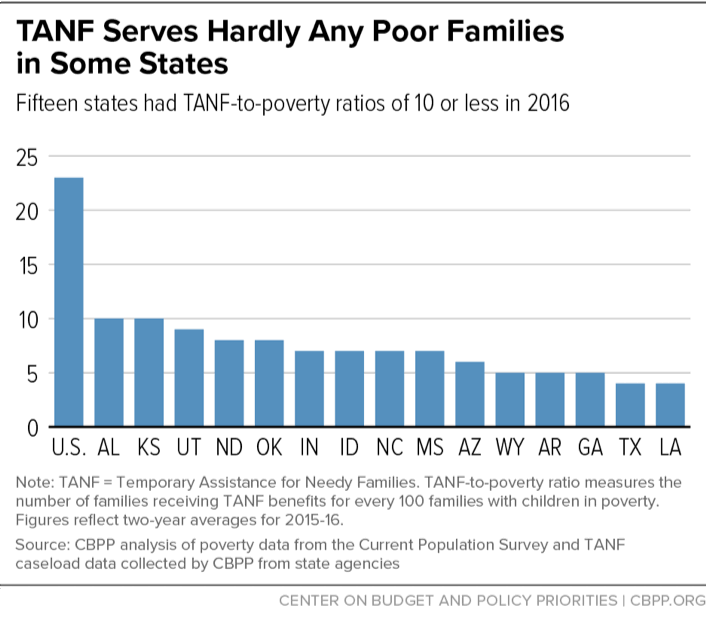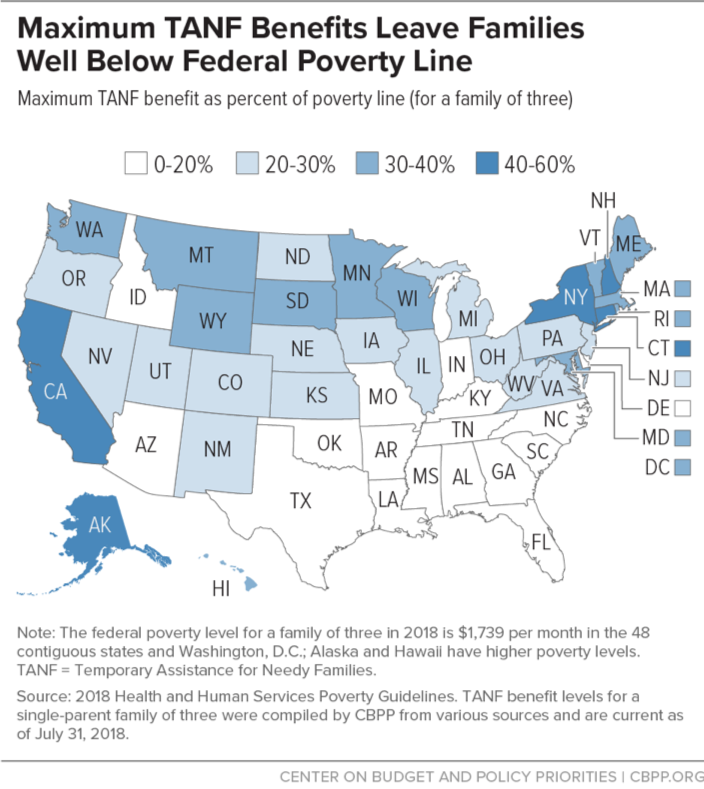BEYOND THE NUMBERS
Twenty-two years ago this week, on August 22, 1996, President Clinton signed a law creating the Temporary Assistance for Needy Families (TANF) block grant and radically restructuring cash assistance for families with children living in poverty. Our week-long blog series examines TANF’s role — and its performance — in helping parents work and in providing modest but crucial anti-poverty support. Today’s post looks at TANF’s declining performance in supporting families in poverty.
TANF reaches far fewer poor families than its predecessor, Aid to Families with Dependent Children (AFDC), and the families who manage to receive TANF cash assistance rely on increasingly inadequate benefits that make it hard for parents and caregivers to provide the basics for their children.
TANF, a block grant with fixed federal funding for a broad set of services, gives states virtually unfettered authority to set their own eligibility policies and strict work requirements. These factors have severely limited the reach of cash assistance. The TANF-to-poverty ratio (TPR), which measures the number of families receiving cash assistance for every 100 families with children in poverty, fell dramatically in the last two decades, from 68 in 1996 to 23 in 2016.
In a growing number of states, TANF reaches almost no families in poverty. In 15 states, the TPR is 10 or less (see chart) — that is, for every 100 families in poverty, 10 or fewer receive cash assistance. In 1996, no state had a ratio that low under AFDC.
For families that do receive TANF cash assistance, the benefits alone don’t cover basic needs. In every state, TANF benefits leave family incomes at or below 60 percent of the poverty line. In 18 states, benefits are at or below 20 percent of the poverty line — that is, $340 a month for a family of three or less. (See map.)
Benefits have lost considerable value in the vast majority of states. Since 1996, they’ve eroded by 20 percent or more in 36 states, after adjusting for inflation. Sixteen states had the same nominal benefit levels in July 2018 as in 1996, meaning that benefits have fallen by 37 percent in inflation-adjusted terms. And four states (Arizona, Hawaii, Idaho, and Oklahoma) have cut benefits in the last 20 years, so benefits there are below their 1996 levels even without adjusting for inflation. In three of those states — Arizona, Hawaii, and Oklahoma — benefits have lost 40 percent or more of their inflation-adjusted value.
One basic need many TANF families struggle to secure is decent housing. Most TANF families don’t receive housing subsidies, and TANF benefits alone often don’t cover average housing costs. The monthly TANF benefit for a family of three is now below the average cost of a modest two-bedroom apartment and utilities in every state. TANF families without housing assistance have high rates of housing instability — sometimes resulting in doubling up with friends or relatives, living in substandard conditions, frequent moves, eviction, and/or homelessness.
As we discussed yesterday, cash income is critical for families and particularly for children’s chances to succeed over the long term. Yet TANF has failed to ensure that the families that most need cash assistance actually receive it and that it’s enough to cover daily essentials. Federal and state policymakers must do more to make the program more accessible and its benefits more adequate. For example, when Congress reauthorizes TANF, it should add a measure of state performance related to program access to encourage states to serve more poor families. State policymakers should step up to raise benefit levels and prevent future erosion through cost-of-living adjustments.
Tomorrow’s post in this series will discuss another area in which TANF has failed: helping families escape poverty through earnings by preparing them for, or connecting them to, jobs.


